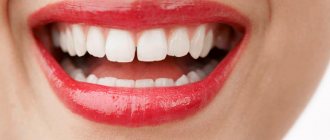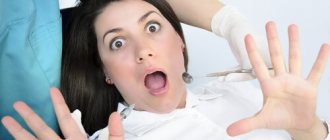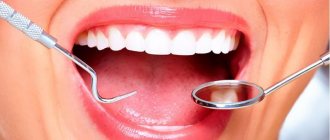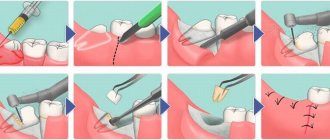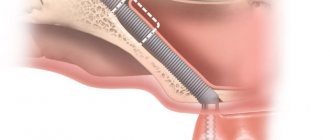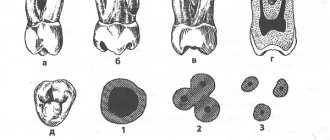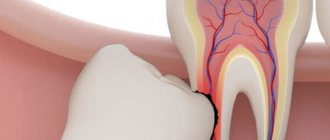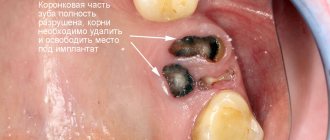A 40-year-old patient came to the clinic of the German Implantology Center with a problem that did not appear overnight. Previously, this patient had a tooth treated - the upper quad, an inlay was installed in it and then a crown was installed on this tooth. The patient had this orthopedic design for about 7 years. Then I began to feel discomfort in the area of tooth 1.4, after a while the crown with the dental inlay fell out, and in the area of the tooth, the gums became sore and a sinus tract appeared on it, from which pus constantly flowed out.
Against the background of this clinical picture, the patient came to us. After a visual examination and 3D tomogram, a decision was made
:
- remove the problematic fourth tooth 1.4,
- treat the fistula on the gum by removing the pus, washing the wound and the fistula on the gum itself,
- install an implant,
- perform a one-time grafting of bone material in order to maintain the profile and volume of hard and soft tissues,
- install a temporary crown.
All treatment proceeded according to the above stages.
In the photo you see the root of the tooth, a broken tooth in area 1.4, and above it you can see a drop - a ball of pus that comes out through the fistula in the gum
. The situation is not easy.
Why did a fistula form on the upper gum?
The upper quadruple tooth is severely damaged and has previously been treated several times. It can be seen that the tooth is discolored, i.e. Previously, treatment was carried out using the resorcinol-formalin method. It is after this method of treatment that the teeth acquire a corresponding brown-violet color, this is clearly visible inside tooth 1.4. By the way, one of the manifestations of treatment with the resorcinol-formalin method is increased fragility of the roots, because they change their physiology, their structure. They become more fragile and brittle. It was impossible to save this tooth; it could not be re-treated. In addition, the tooth had a crack in the root in the area of the removed root tab, which supported the tooth crown. All of this together caused the development of the inflammatory process, and then a fistula on the gum in the area of tooth 1.4.
Braces and wisdom teeth removal
On the Internet you can find a lot of information that before orthodontic treatment it is imperative to eliminate the eighth teeth. However, this statement is not entirely correct: “eights” are not always disposed of, but only in cases of extreme necessity. As a preventative measure, removing third molars is incorrect and even dangerous. Correctly erupted “eights” are the same part of the dentofacial apparatus as other teeth, provided, of course, that they have antagonists. Moreover, extracting the “eight” is not such an easy process.
Interesting fact!
In cases where there is clearly not enough space in the bone for the correct placement of teeth, specialists can remove the “eights” without waiting for them to erupt.
Nevertheless, when a patient is indicated for removal, experts pay attention to the wisdom teeth first - and here's why.
- They erupt later than others, between 16 and 27 years, which often negates the results of treatment carried out in adolescence.
- The process of their eruption is often associated with various complications (in about 75% of cases) - and this also affects the location of other teeth.
- “Wise” teeth sometimes remain impacted and do not participate in the bite, which makes them an unnecessary vestigial organ and a prime candidate for removal. However, there are situations when the patient simply does not have third molars or their extraction is not enough to correct the anomaly - in this case, it is necessary to resort to the removal of other teeth.
What teeth are usually suggested to be removed?
To maintain symmetry, teeth are usually removed in pairs. The most rational way to free up space for teeth straightening is to remove the “eights” - wisdom teeth. Their functionality is low, they often cause discomfort to their owners and often cause changes in the correct bite - if they grow at an angle, shifting the remaining teeth to the center. In this case, their removal is simply necessary to restore a physiological bite.
The situation is more complicated with patients who have problems with the dentition due to a lack of space on the front (front) part of the jaw. If the front teeth are crowded, a procedure may be suggested to remove premolars—usually quads. They have small roots and are the easiest to remove, and in most cases their absence does not lead to any discomfort. If the patient’s “fours” are healthy, but the “fives” or “sixes” turn out to be problematic, a decision may be made to remove the last pair.
Removing "fours" or "sixes"
Sometimes, before installing braces, the patient needs to have the “fours” removed, that is, the first premolars - they have the smallest roots, so they are the easiest to pull out.
In addition, they bear less chewing load than, for example, molars, so their loss will not affect the patient’s health. The third candidate for removal is the fifth teeth. They are slightly larger than the “fours”, but the gaps left after their removal are practically unnoticeable when talking and smiling. Frontal teeth and canines undergo extraction much less frequently. “Sixes” are removed as a last resort, since they are quite difficult to remove, and the holes left behind them take a long time to heal. As for the seventh tooth, it is pulled out only if there is a healthy eighth tooth, in order to shift part of the load onto it. In addition, which teeth need to be extracted depends on the type of bite.
✔
In case of crossbites and distal bites, premolars, that is, either the fourth or fifth teeth, are most often removed.
✔
In case of an open bite associated with severe crowding and/or protrusion - protrusion of one of the jaws, removal of the upper and lower premolars, and at a very young age, also the canines, is indicated.
✔
As for the mesial bite, to correct it, the lower incisors are eliminated - in case of underdevelopment of the upper jaw - or “eights”.
Important!
A competent specialist, regardless of the indications, will always prefer to remove a diseased or decayed tooth rather than a healthy one.
Briefly about braces
They are a system of individual locks and wires that connect them into a single arc. The clasps are fixed with glue on each dental unit. Then a wire is inserted into the grooves, which, in an effort to straighten, moves the teeth in the desired direction.
The brace system evenly distributes the load, eliminates pain when chewing food, reduces the risk of developing caries, diseases of the upper respiratory tract, oral cavity, and eliminates injuries to the cheeks and tongue from protruding elements.
The design does not violate the integrity of tissues, which is very important for preserving the beauty and health of teeth for many years.
Tooth extraction before installing braces and treatment time
In most cases, contrary to popular belief, extraction does not increase the treatment time, but, on the contrary, shortens it. For example, if the patient has severe crowding, then extraction will speed up the process of moving teeth by at least a couple of months, if not more. However, if the situation allows you to do without removal, then the fate of the tooth depends on the patient’s decision. In addition, you should not be afraid that after extraction there will be gaps between the teeth - they will close during orthodontic treatment. Usually it takes from three months to six months to eliminate them, depending on which tooth was removed. The gaps close at a rate of approximately 1 mm per month, so the smaller the tooth removed, the faster they will heal. As mentioned earlier, the smallest holes remain after removing the “fours”. Extraction is usually performed a week before braces are installed.
Important!
Removing an inflamed tooth during orthodontic treatment can negatively affect the timing of correction, therefore, before installing braces, the oral cavity must be completely sanitized.
Installation of a temporary crown
On the same day, 1 hour after installation of the implant, the patient was fixed with a temporary crown
:
We see it in the chewing projection. We see the shaft where the screw fixation
this temporary crown. The crown is clearly in the right position.
And this is what the temporary crown looks like in the lateral projection. The installed tooth looks very natural; just above it we see traces of a fistula on the gum of the tooth, from which pus had previously leaked. The wound from the fistula, as I said earlier, was washed and treated according to the protocol.
The patient was very pleased. Yes, the situation was not pleasant, but we successfully dealt with it.
Is it possible to avoid tooth extraction?
In order not to be faced with the choice of which tooth to remove and whether it is worth doing it, it is necessary to monitor the formation of the child’s bite from an early age. Many parents believe that they need to make an appointment with an orthodontist only when baby teeth are replaced by permanent teeth. This is an erroneous opinion: it is recommended to show the child to a specialist for the first time at the age of 2-3 years, so that the doctor can identify the prerequisites for the development of dental anomalies in time.
What do parents of young children need to pay attention to?
- On the child’s bad habits (constantly sucking his thumb, chewing on various objects, and will not part with his pacifier). Even improper bottle feeding can lead to underdeveloped jaws.
- Due to adenoids or frequent acute respiratory viral infections, the child adapts to improper (oral) breathing, and this negatively affects the condition of the entire dental system.
- Children sleep incorrectly (throw their heads back too far, put their fists under their cheeks, etc.). They don't watch their posture. All this prevents the correct formation of the dentition and the temporomandibular joint.
If these problems are addressed in a timely manner, then in the future there may be no need to remove healthy teeth that interfere with orthodontic correction. The orthodontist will prescribe myogymnastics and select vestibular plates and trainers. Treatment in adulthood, if carried out, will be more comfortable and take less time.
The patient has the last word
In any case, tooth extraction is not a common, everyday practice for an orthodontist. The decision on the advisability of removing wisdom teeth and premolars is made only after a thoughtful diagnosis of the patient and a thorough analysis of the consequences of such an intervention.
You should not be afraid of the void in the dentition formed after the removal of premolars. When wearing self-ligating braces installments , neighboring teeth will move into this place, quickly restoring the visual integrity of the dentition.
Once you decide to straighten your teeth, you need to find an orthodontist whom you can trust to create your future beautiful smile. If you initially do not agree to surgery and do not want to part with healthy teeth, or the specialist’s evidence does not seem reasonable to you, consult with other doctors. The result of treatment, one way or another, will depend on your mood, and the final say in choosing a treatment plan remains only with you.
Does it make sense to wear braces without removing teeth?
As we have found out, removal is required in cases where there is not enough space in the jaw for the correct arrangement of teeth. Unfortunately, without extraction in such situations, orthodontic treatment will be ineffective. The teeth, taking the desired position, will either be forced to shift their inclination, or simply will not budge. Only timely orthodontic treatment in childhood will help to avoid removal.
Publisher: Expert magazine about dentistry Startsmile.ru
Author of the material: Yaroslav Ikonnikov
Is it painful to remove molars?
Today, only older people remember the terrible pain during the removal of molars. Nowadays, the quality of painkillers is so high that the patient does not feel pain at all, even with difficult removal. At the same time, after the anesthesia wears off, pain, of course, occurs, but it is quite tolerable and depends on how much the gum under the tooth was disturbed.
If the pain is still severe, then the dentist recommends taking a painkiller tablet. The same analgin successfully dulls pain for a long time.
In rare cases, the patient may experience throbbing and increasing pain. This annoying phenomenon occurs due to inflammation of the socket. If measures are not taken quickly, the tissue begins to fester in the hole. This process can be suppressed with drug treatment, but sometimes you have to open the gum and clean the hole from pus.
Is it possible to remove it if the braces system is already installed?
Note: It is advisable to carry out all preparatory procedures, including the removal of interfering teeth, before installing braces.
But the occurrence of a jaw injury and other situations when a braces system is already in place can lead to the need to remove the jaw organs when the structure is already installed.
In such a situation, the orthodontic arch is cut to the fangs, the molars are freed from the clasps and removal is performed. In this case, the bracket system continues its work in the same rhythm.
Features of complex operations
Removing eights becomes more difficult if:
- location on the lower jaw. The lower teeth have a more massive and developed root system, and higher jaw bone density;
- tooth growth at an angle to the dentition or in a horizontal direction;
- incomplete eruption;
- tortuosity, entanglement of roots, especially when there are many of them;
- proximity of neighboring units, making it difficult to remove the figure eight;
Complex removals can be performed not only under local anesthesia, but also with sedation. Painkillers are administered together with sedatives and are selected individually. Operations under sedation provide psychological comfort and painlessness.
Rehabilitation
During the recovery period, dentists prescribe a course of antibacterial therapy and painkillers for the shortest possible course. That is, you should take analgesics as long as the pain persists. Most often, non-steroidal anti-inflammatory drugs based on ibuprofen and nimesulide (Nise) are prescribed for pain, which effectively relieve both pain and inflammation.
Antihistamines are prescribed to prevent generalized swelling in the area of the tooth socket.
It is highly advisable to quit smoking: nicotine interferes with the normal blood clotting process and can cause bleeding.
To speed up wound healing, it is recommended to rinse your mouth with antiseptics and eat liquid and soft foods for several days.
Content
- There are two types of extraction
- How many teeth can be removed at once?
- Conclusion
A diseased tooth cannot always be treated. Patients often put off going to the dentist for various reasons. Such actions trigger destructive mechanisms in dental tissues.
Due to lack of treatment:
- Caries transforms into pulpitis;
- Further - into periodontitis, which is accompanied by cysts, fistulas and granulomas;
- The likelihood of developing periostitis of the jaw increases.
In case of high risks, the only correct solution is tooth extraction.
Such an outcome is always undesirable for the patient, because the next stage becomes another problem - the need for prosthetics.
Doctors always make every effort to save teeth, but this is not always possible. It happens that several teeth must be removed at once.
PROMOTION
Inexpensive tooth extraction
from 1000 rub.
